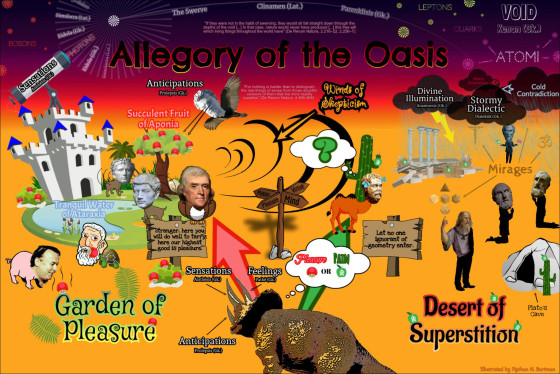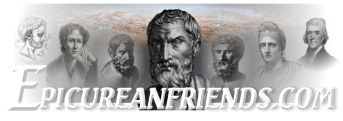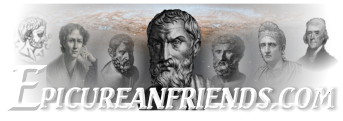UPDATE: The most recent version of the graphic, discussed in the posts at the end of this chain, is this one:

The following thread discusses the evolution of this graphic. Each panel describes its significance, but in case you don't recognize the characters portrayed above each one, here's a quick description:
- Nothing but young animals here, representing (among other things) the unperverted source of information to which Epicurus looks for the guidance of Nature.
- Zeno the Stoic
- Transition panel
- Plato
- Marcus Aurelius, an eclectic who preserved some Epicurean views but was mostly Stoic.
- Transition panel
- ____ and Thomas Jefferson
- ????
- Epicurus
- Garden of Pleasure
________________

This post is for discussion of Nate's "Allegory of the Oasis" graphic. Comments to it can also be posted in the gallery, but this thread is for discussion of the details and changes over time.
Here is the most well-developed summary of its content, but this needs revision:
In the garden, we have self-described Epicureans, with Christopher Hitchens on the left, and then Horace, Virgil, Lucretius, and Thomas Jefferson going right. Continuing into the Desert, we have influential Stoics and Platonists including Chrysippus, Plato, Plotinus, and Zeno of Citium.
Each of the Epicureans is related to an "unclean" animal. Each "unclean" animal is engaging one of the five sensual activities, such as Lucretius the vulture seeing, Jefferson the desert owl clasping the sign with his talons, and Christopher Hitchens the pig smelling a mushroom.
Each of the Idealist philosophers is depicted as a shadow, unconcerned with their physical bodies, believing themselves only to be a mind/soul. The are glorifying ideas, and worshiping mathematical forms. The two Stoics are praying and the Platonists are contemplating formal mathematics.
The mirages (we reject) include the Platonic Forms, a male deity holding the Earth (suggesting omniscience and sovereignty), a crucifix (suggesting immanence), and the name of the Jewish deity in Hebrew (ineffability and incorporeality). The Hebrews get a special shout-out in the diagram for bastardizing the name of our founder into their word for 'heretic' ('epikoros' or '????????'). Consequently, you will find the Tetragrammaton fading in the horizon.
Our protagonist is a camel � inherently carrying the placid waters of Ataraxia through the desert. The hero begins to dehydrate, and grows thirsty. By trusting the judgment of his feelings, the camel follows his natural anticipations to a place that will satisfy his hunger and quench his thirst. The desert Idealists are hallucinating from fasting. There's a fairly good chance Plotinus is about to have a heat stroke.
There are pleasureful mushrooms, and painful, poison apples all around! The Garden, having been cultivated by the animals living within, is mostly filled with mushrooms, though some poison apples are growing at the outskirts of the oasis. The desert is the opposite � it almost exclusively grows poison apples. Such are the consequences if one ignores their physical needs.
The Epicureans have constructed a dwelling in the Garden that contains an observatory � see the telescope at the top of the castle. Supported upon the foundation of the Garden, it has the clarity and stability to observe the physical working of the world; the telescope sees through the mirages of the desert.
The water is 'Ataraxia' as opposed to the fruit, being 'Aponia.' I equate taking a bath or swimming to be more of a 'mind-easing' activity, and eating or drinking to be more of a 'body-pleasing' activity. Consequently, lack of mental disturbance is represented by a smooth pond, and lack of physical disturbance is represented by juicy fruit.

